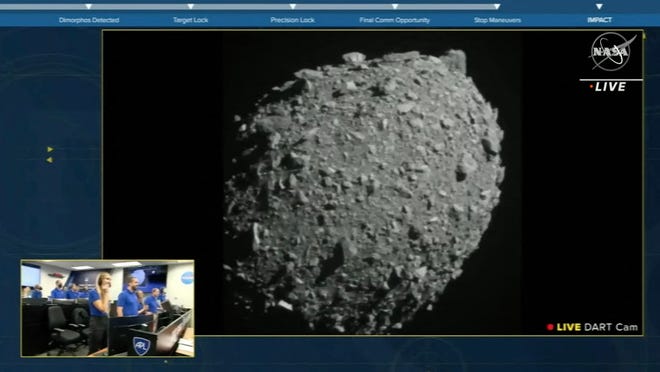Mission completed.
NASA crashed a spacecraft into a asteroid Monday. It was a major victory in the agency’s plan to deal with a potentially devastating asteroid.
The 1,260-pound Double Asteroid Redirection Test spacecraft, or DART, collided with the estimated 11 billion pound, 520-foot long asteroid Dimorphos at 14,000 miles per hour close to 7 million miles from Earth. The spacecraft was approximately 55 feet away from the asteroid’s centre.
The spacecraft had launched its camera and a shoebox-size companion, LICIACube, over a week ago to photograph the mission, which confirmed the impact.
“This was a really hard technology demonstration to hit a small asteroid we’ve never seen before, and do it in such spectacular fashion,” Nancy Chabot, planetary scientist and mission team leader at Johns Hopkins University, said after the impact.
The completed mission culminates a 10-month-long journey for DART, which cost $325 million. The asteroid orbits a larger one named Didymos, and the two were chosen because they don’t pose any threat to Earth.
NASA Administrator Bill Nelson said, “There was a lot innovation and creativity that went into the mission, and it’s going teach us how one day we can protect our own planet against an incoming asteroid.” “We’re showing the world that planet defense can be done globally, and it’s possible to save our planet.
VISUAL EXPLAINER Go inside NASA’s plan to crash the DART spacecraft into an asteroid
DART Team stated that no adjustments were necessary for the mission, and that it was in line with our expectations.
While DART successfully hit Dimorphos, NASA won’t know for weeks – possibly months – about the collision effects.
After the impact, Elena Adams, mission system engineer, said that “some things will likely come out even in days, maybe weeks.” “But I would suggest that for the quantitative answer, it takes a couple months.”
It was not the agency’s intention to destroy the asteroid. The agency hoped to shift its orbit about Didymos so that it alters both their trajectories. Dimorphos orbits around Didymos in 11h 55 minutes. NASA hopes that the collision will reduce its orbit by 10 seconds.
But changing an asteroid’s orbit by just 1% could be enough if a destructive one were headed towards Earth, NASA says. There are currently nearly 30,000 objects near Earth in the solar system. according to NASA, meaning they come within 120.8 million miles of our planet. Over 10,000 of near-Earth objects them around the same size as Dimorphos.

Experts in planetary defense prefer to nuke a dangerous asteroid or comet, provided they have enough time, over blowing it up and creating many pieces that could hit Earth. For large space rocks, multiple impactors may be required. A combination of impactors with gravity tractors (non-patented devices that use their own gravity to pull an object into a safer orbit) might also be necessary.
Although no asteroids that large are expected to strike Earth in the next 100 year, only 40% have been found as of October 20, 2021. NASA says. We know less than 1% of the millions smaller asteroids that are capable of causing widespread injuries.
For now, however, astronomers suggest that humanity should feel safe.
Adams stated that “our first planetary defense test was successful.” “Earthlings should have better sleep.”
Contributing: Associated Press
Follow Jordan Mendoza via Twitter: @jordan_mendoza5.
from Salem – Salem Local News https://bit.ly/3fntmc7
via IFTTT
No comments:
Post a Comment
Note: Only a member of this blog may post a comment.